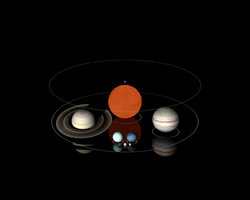OGLE-TR-122
| Observation data Epoch J2000.0 Equinox J2000.0 (ICRS) | |
|---|---|
| Constellation | Carina |
| Right ascension | 11h 06m 51.99s[1] |
| Declination | −60° 51′ 45.7″[1] |
| Characteristics | |
| Spectral type | ? (primary)/M (b)[2] |
| Apparent magnitude (I) | 15.61 (system)[1] |
| Variable type | Eclipsing binary |
| Orbit[2] | |
| Period (P) | 7.26867 d |
| Eccentricity (e) | 0.205 ± 0.008 |
| Inclination (i) | 88–90° |
| Periastron epoch (T) | JD 2452342.41 ± 0.02 |
| Argument of periastron (ω) (secondary) | 99.2 ± 0.8° |
| Semi-amplitude (K1) (primary) | 9.642 ± 0.088 km/s |
| Details[2] | |
| OGLE-TR-122A | |
| Mass | 0.98 ± 0.14 M☉ |
| Radius | 1.05+0.20 −0.09 R☉ |
| Surface gravity (log g) | 3.9 ± 0.5 cgs |
| Temperature | 5700 ± 300 K |
| Metallicity [Fe/H] | 0.15 ± 0.36 dex |
| Rotational velocity (v sin i) | 5.7 ± 0.6 km/s |
| OGLE-TR-122B | |
| Mass | 0.092 ± 0.009 M☉ |
| Radius | 0.120+0.024 −0.013 R☉ |
| Other designations | |
V817 Car | |
| Database references | |
| SIMBAD | data |
OGLE-TR-122 is a binary stellar system containing one of the smallest main-sequence stars whose radius has been measured. It was discovered when the Optical Gravitational Lensing Experiment (OGLE) survey observed the smaller star eclipsing the larger primary. The orbital period is approximately 7.3 days. The system's primary is thought to resemble the Sun.[2]
OGLE-TR-122B
The smaller star, OGLE-TR-122B, is estimated to have a radius around 0.12 solar radii, or around 20% larger than Jupiter's, and a mass of around 0.1 solar masses, or approximately 100 times Jupiter's. This makes its average density approximately 50 times the Sun's[2][3] or over 80 times the density of water. OGLE-TR-122b's mass is close to the lowest possible mass for a hydrogen-fusing star, estimated to be around 0.07 or 0.08 solar masses.[4] The observed transit provides the first direct evidence for a star with a radius comparable to Jupiter's.[2]
-
Brightness «Dip» and Velocity Variations of OGLE-TR-122.
See also
References
- ^ a b c The Optical Gravitational Lensing Experiment. Additional Planetary and Low-Luminosity Object Transits from the OGLE 2001 and 2002 Observational Campaigns, A. Udalski, G. Pietrzynski, M. Szymanski, M. Kubiak, K. Zebrun, I. Soszynski, O. Szewczyk, and L. Wyrzykowski, Acta Astronomica 53 (June 2003), pp. 133–149.
- ^ a b c d e f Pont, F.; Melo, C. H. F.; Bouchy, F.; Udry, S.; Queloz, D.; Mayor, M.; Santos, N. C. (2005). "A planet-sized transiting star around OGLE-TR-122". Astronomy and Astrophysics. 433 (2): L21. arXiv:astro-ph/0501611. Bibcode:2005A&A...433L..21P. doi:10.1051/0004-6361:200500025. S2CID 14799999.
- ^ Newfound Star Smaller than Some Planets, Robert Roy Britt, space.com, accessed on line May 16, 2007.
- ^ Chabrier, Gilles; Baraffe, Isabelle (2000). "Theory of Low-Mass Stars and Substellar Objects". Annual Review of Astronomy and Astrophysics. 38: 337–377. arXiv:astro-ph/0006383. Bibcode:2000ARA&A..38..337C. doi:10.1146/annurev.astro.38.1.337. S2CID 59325115.

